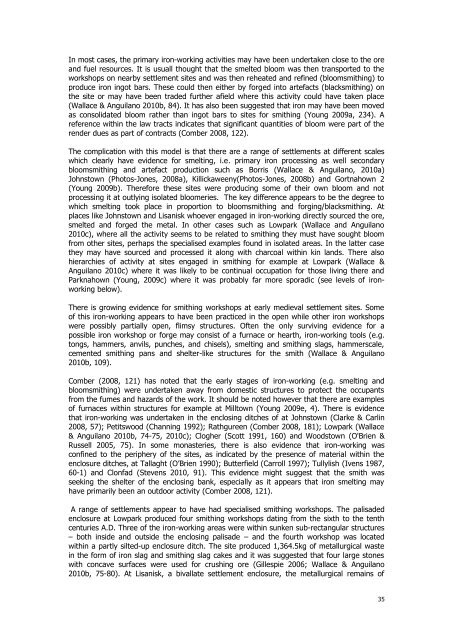EMAP_2012_Report_6_1.pdf (7.3 MB) - The Heritage Council
EMAP_2012_Report_6_1.pdf (7.3 MB) - The Heritage Council
EMAP_2012_Report_6_1.pdf (7.3 MB) - The Heritage Council
You also want an ePaper? Increase the reach of your titles
YUMPU automatically turns print PDFs into web optimized ePapers that Google loves.
In most cases, the primary iron-working activities may have been undertaken close to the ore<br />
and fuel resources. It is usuall thought that the smelted bloom was then transported to the<br />
workshops on nearby settlement sites and was then reheated and refined (bloomsmithing) to<br />
produce iron ingot bars. <strong>The</strong>se could then either by forged into artefacts (blacksmithing) on<br />
the site or may have been traded further afield where this activity could have taken place<br />
(Wallace & Anguilano 2010b, 84). It has also been suggested that iron may have been moved<br />
as consolidated bloom rather than ingot bars to sites for smithing (Young 2009a, 234). A<br />
reference within the law tracts indicates that significant quantities of bloom were part of the<br />
render dues as part of contracts (Comber 2008, 122).<br />
<strong>The</strong> complication with this model is that there are a range of settlements at different scales<br />
which clearly have evidence for smelting, i.e. primary iron processing as well secondary<br />
bloomsmithing and artefact production such as Borris (Wallace & Anguilano, 2010a)<br />
Johnstown (Photos-Jones, 2008a), Killickaweeny(Photos-Jones, 2008b) and Gortnahown 2<br />
(Young 2009b). <strong>The</strong>refore these sites were producing some of their own bloom and not<br />
processing it at outlying isolated bloomeries. <strong>The</strong> key difference appears to be the degree to<br />
which smelting took place in proportion to bloomsmithing and forging/blacksmithing. At<br />
places like Johnstown and Lisanisk whoever engaged in iron-working directly sourced the ore,<br />
smelted and forged the metal. In other cases such as Lowpark (Wallace and Anguilano<br />
2010c), where all the activity seems to be related to smithing they must have sought bloom<br />
from other sites, perhaps the specialised examples found in isolated areas. In the latter case<br />
they may have sourced and processed it along with charcoal within kin lands. <strong>The</strong>re also<br />
hierarchies of activity at sites engaged in smithing for example at Lowpark (Wallace &<br />
Anguilano 2010c) where it was likely to be continual occupation for those living there and<br />
Parknahown (Young, 2009c) where it was probably far more sporadic (see levels of ironworking<br />
below).<br />
<strong>The</strong>re is growing evidence for smithing workshops at early medieval settlement sites. Some<br />
of this iron-working appears to have been practiced in the open while other iron workshops<br />
were possibly partially open, flimsy structures. Often the only surviving evidence for a<br />
possible iron workshop or forge may consist of a furnace or hearth, iron-working tools (e.g.<br />
tongs, hammers, anvils, punches, and chisels), smelting and smithing slags, hammerscale,<br />
cemented smithing pans and shelter-like structures for the smith (Wallace & Anguilano<br />
2010b, 109).<br />
Comber (2008, 121) has noted that the early stages of iron-working (e.g. smelting and<br />
bloomsmithing) were undertaken away from domestic structures to protect the occupants<br />
from the fumes and hazards of the work. It should be noted however that there are examples<br />
of furnaces within structures for example at Milltown (Young 2009e, 4). <strong>The</strong>re is evidence<br />
that iron-working was undertaken in the enclosing ditches of at Johnstown (Clarke & Carlin<br />
2008, 57); Petitswood (Channing 1992); Rathgureen (Comber 2008, 181); Lowpark (Wallace<br />
& Anguilano 2010b, 74-75, 2010c); Clogher (Scott 1991, 160) and Woodstown (O'Brien &<br />
Russell 2005, 75). In some monasteries, there is also evidence that iron-working was<br />
confined to the periphery of the sites, as indicated by the presence of material within the<br />
enclosure ditches, at Tallaght (O’Brien 1990); Butterfield (Carroll 1997); Tullylish (Ivens 1987,<br />
60-1) and Clonfad (Stevens 2010, 91). This evidence might suggest that the smith was<br />
seeking the shelter of the enclosing bank, especially as it appears that iron smelting may<br />
have primarily been an outdoor activity (Comber 2008, 121).<br />
A range of settlements appear to have had specialised smithing workshops. <strong>The</strong> palisaded<br />
enclosure at Lowpark produced four smithing workshops dating from the sixth to the tenth<br />
centuries A.D. Three of the iron-working areas were within sunken sub-rectangular structures<br />
– both inside and outside the enclosing palisade – and the fourth workshop was located<br />
within a partly silted-up enclosure ditch. <strong>The</strong> site produced 1,364.5kg of metallurgical waste<br />
in the form of iron slag and smithing slag cakes and it was suggested that four large stones<br />
with concave surfaces were used for crushing ore (Gillespie 2006; Wallace & Anguilano<br />
2010b, 75-80). At Lisanisk, a bivallate settlement enclosure, the metallurgical remains of<br />
35
















